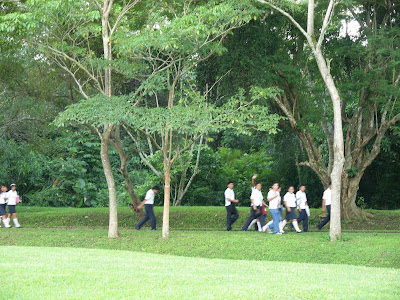
Comalcalco – These are the Roman Mayan ruins. The only ruins with baked brick. And on the back of the brick are symbols, similar to symbols in Roman bricks to show who made them. And there were some heads that looked more like Romans than Mayans. We didn’t get to see that stuff since the museum was closed. But we saw the ruins. At the foot of one temple/pyramid was a big frog ruin, as if it supported the building on its back. There were a lot of hills that looked like they had more temples underneath. They sure had a lot of temples, I mean, what did they do with them all? We were in the jungle, and from the top of the pyramids/ruins you could look out over the top of the trees, all the different greens. We saw two iguanas under the bricks. And Virginia got a den of ants mad. I found a tree that sounded hollow when you thumped it, like a water melon. Virginia ran down a hill to read a sign, and ran through a little swamp. “I hope I don’t get leaches!” she yelled.
 School field trip
School field tripWe ran into an American who told us where the chocolate place was. Tours were 70 peasos each, so we didn’t do it. But we sampled roast cacao beans and chocolate made there. It was good, not the waxy American Hershey’s stuff. It was better than Russian, Swiss, and Finnish, just plain chocolate.
We took a dinky backroad that we heard about to Villahermosa. It was a better road than the secondary highway we took in, but not as interesting or wild.
- Angela
At Comalcalco the pyramids were exactly like I envisioned them when I thought of ancient Nephite cities in the middle of the green green jungles. They were made out of brick and were all dark gray. Bright green moss covered the steps pecked out from every crack. I’m so impressed by all the green! The pyramids looked like they had grown right out of the green, and the green mounds around them would soon sprout more. Besides green and bricks we encountered other jungle aspects. Dad got snapshots of iguanas. Angela found and Elena and I poked a tiny frog around. I had the fortune of discovering the ant den, and Caleb slid gracefully into a swamp. We all came out with a few more mosquito bites. Yep, we’re in the jungle.
We are now in Villahermosa, and it is raining.
- Virginia
 Jungle reptile
Jungle reptile We dropped by a Soriana for bread, avocados, shelf milk, and water. After breakfasting on those, we visited the ruins. They were only partly restored and the museum, which would have told us a lot, is under construction. Comalcalco ruin was the visit of the day, the site of an Olmec ruin. It is notable because it has fired bricks to cover the pyramid, which is made of sun dried adobe mud bricks. They used fired bricks probably because they did not have rocks for a veneer as the other pyramids had. It is located within a few miles of the Caribbean Sea. All the land around is low, even marshy at times.

We ate lunch in a café run by a gringo from Oregon. It violated Naomi’s rule of not eating when there are no other customers, but it was good food. Edwin had met the fellow in the Zocolo. He gets an allowance from his Mother in Oregon, probably to keep him down here and away from home. He did not know a place to exchange for pesos and did not know the exchange rate; all he cared about was how many pesos he got each month from mama.
- Grandpa
Though the museum at Comalcalco was closed, we had some information from the Internet that talked about the Roman-style bricks, and showed the similar markings on the backs of the bricks, as well as a Roman-looking sculptured head.
Some pyramids are build on natural hills. Most pyramids are build in three layers: inside of adobe brick, outside covered with stone, and then plastered with cement. These ruins are the only ones with fired brick.

So, in keeping with what we’ve seen of archaeology, we each made a theory.
Augustus said that the Romans sent a conquering ship, which conquered that particular area.
I said that some Roman ship was blown off course, and was glad to finally make land. However, they were not glad to be made prisoners and slaves, captured by the Mayans, and forced to work on the great building projects. One of them was clever: He saw the trouble the natives were having trying to plaster over mud, and told them he could solve their problem. He accordingly built a kiln and delivered on his promise, in return for his own freedom, and the gift of his own men. He subsequently had a sculpture made of himself, thus memorializing the brief Roman presence in the New World.
Edwin said that one native woman was a poor pot-maker. When her pyramid-building husband noticed the pile of discarded pieces in the corner, he realized he could use them in the pyramid. So her failure was turned into success. (Did not explain the Roman head).
We have noticed that many people look just like the Mayan sculptures.
- Naomi

No comments:
Post a Comment